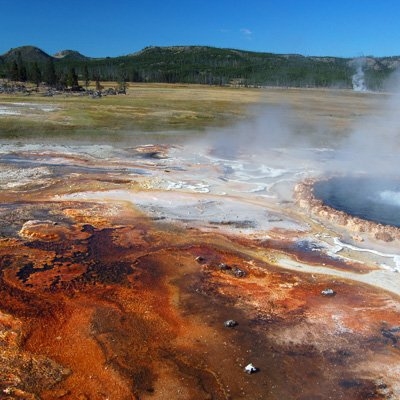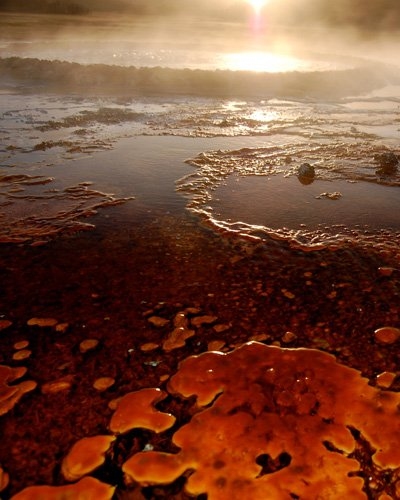About 85 percent of the history of life on Earth has been solely microbial, meaning that single-celled organisms ruled the planet for billions of years before more complex life evolved. One way that geologists try to decipher how these cells functioned as far back as 3 billion years is by studying modern microbial mats, or gooey layers of nutrient-exchanging bacteria that grow mostly on moist surfaces.
These layers collect dirt and minerals that crystallize over time. Eventually, the bacteria turn to stone just beneath the crystallized material, thereby recording their history within the crystalline skeletons. Known as stromatolites, the layered rock formations are considered to be the oldest fossils on Earth. While there are many kinds of stromatolites, many geologists believe that the odd triangular patterns of conical stromatolites are the purest record of bacterial growth because they form as a result of only two processes: the growth of bacteria and the growth of mineral crystals.
Deciphering the few clues about ancient bacterial life that are seen in these poorly preserved rocks has been difficult, but researchers from MIT’s Department of Earth, Atmospheric and Planetary Sciences (EAPS) and the Russian Academy of Sciences may have found a way to glean new information from the fossils. Specifically, they have linked the even spacing between the thousands of tiny cones that dot the surfaces of stromatolite-forming microbial mats — a pattern that also appears in cross-sectional slices of stromatolites that are 2.8 billion years old — to photosynthesis. The connection could help scientists put a better range on when photosynthesis started.
In a paper published Monday in the Proceedings of the National Academy of Science, the researchers suggest that the characteristic centimeter-scale spacing between neighboring cones that appears on modern microbial mats and the conical stromatolites they form occurs as a result of the daily competition for nutrients between neighboring mats. According to lead author and EAPS graduate student Alexander Petroff, the research suggests a physical understanding of how the morphology, or shape, of a bacterial community records its ability to use light as an energy source.
The research, which was funded by NASA, the National Science Foundation and the Solomon Buchsbaum Fund, also provides a new technique for interpreting the patterns of these ancient fossils, according to Petroff. By analyzing the length of the triangular patterns seen in an ancient stromatolite, for example, geologists can now infer more details about the environment in which the microbial mat lived, such as whether it lived in still or turbulent water.
The physics of photosynthesis
Until now, no one had explored the consistent one-centimeter spacing that appears between the tiny cones featured on microbial mats and conical stromatolites that grow in the hot springs of Yellowstone National Park, and at other locations around the world. Petroff and his colleagues, including EAPS professors Daniel Rothman and Tanja Bosak, proposed that the pattern was not coincidental and could pertain to a biophysical process, such as how the bacteria compete for nutrients.
By studying the physics of photosynthesis, the researchers formed a better understanding of how a mat consumes nutrients from its surroundings over the course of a day, and then metabolizes, or breaks down, those nutrients for energy.
During the daytime, a mat takes in nutrients like inorganic carbon from its immediate surroundings and uses energy from sunlight to build sugars and new bacteria. As these nutrients become locally depleted, the mat starts to consume nutrients from larger distances. At nighttime when it is dark and photosynthesis is not possible, nutrients return to the water immediately surrounding the mat.
After studying this process in detail, the researchers reasoned that in order to avoid direct competition for nutrients, the spacing between mats must be influenced by diffusion, or how molecules spread out over time. In this case, diffusion is itself influenced by the amount of time a mat is metabolically active, which varies over the course of a day due to changes in sunlight. Therefore, the spacing between cones records the maximum distance that mats can compete with one another to metabolize nutrients that are spread by diffusion and later replenished at night. After testing this theory on cultures in the lab, the researchers confirmed their hypothesis through fieldwork in Yellowstone, where the centimeter spacing between mats corresponds to their metabolic period of about 20 hours.
That the spacing pattern corresponds to the mats’ metabolic period — and is also seen in ancient rocks — shows that the same basic physical processes of diffusion and competition seen today were happening billions of years ago, long before complex life appeared. The spacing between individual mats also reveals other factors about a mat’s environment, the researchers say. For example, if the spacing is larger than one centimeter, this could be evidence that the bacteria lived in a turbulent environment. This is because when bacteria compete for nutrients in stirred, rather than still, water, this motion means they can consume nutrients from greater distances, meaning competition isn’t as fierce, and the mats can be more spread apart from one another.
Paul Hoffman, a recently retired Harvard geologist, believes that the theoretical explanation will be of use to geologists because it can be easily observed and tested in the field. But he said it will be difficult to differentiate the patterns seen in the stromatolites studied by Petroff’s team — that is, stromatolites that are produced by biological processes — from those that grow solely from physical processes related to sedimentation. Because the growth of both kinds may be governed by diffusion of nutrients or ions, it is important that future research demonstrates that non-living stromatolites do not exhibit the same spacing relationship as living stromatolites, he said.
Petroff agreed with Hoffman, noting that his research about the spacing between the cones of stromatolites is only part of what is required to interpret Earth’s earliest fossils properly, and that much work remains in order to address fundamental questions that have eluded a complete understanding. His group is currently working to address one of those questions — why biological stromatolites form cones instead of other shapes.
These layers collect dirt and minerals that crystallize over time. Eventually, the bacteria turn to stone just beneath the crystallized material, thereby recording their history within the crystalline skeletons. Known as stromatolites, the layered rock formations are considered to be the oldest fossils on Earth. While there are many kinds of stromatolites, many geologists believe that the odd triangular patterns of conical stromatolites are the purest record of bacterial growth because they form as a result of only two processes: the growth of bacteria and the growth of mineral crystals.
Deciphering the few clues about ancient bacterial life that are seen in these poorly preserved rocks has been difficult, but researchers from MIT’s Department of Earth, Atmospheric and Planetary Sciences (EAPS) and the Russian Academy of Sciences may have found a way to glean new information from the fossils. Specifically, they have linked the even spacing between the thousands of tiny cones that dot the surfaces of stromatolite-forming microbial mats — a pattern that also appears in cross-sectional slices of stromatolites that are 2.8 billion years old — to photosynthesis. The connection could help scientists put a better range on when photosynthesis started.
In a paper published Monday in the Proceedings of the National Academy of Science, the researchers suggest that the characteristic centimeter-scale spacing between neighboring cones that appears on modern microbial mats and the conical stromatolites they form occurs as a result of the daily competition for nutrients between neighboring mats. According to lead author and EAPS graduate student Alexander Petroff, the research suggests a physical understanding of how the morphology, or shape, of a bacterial community records its ability to use light as an energy source.
The research, which was funded by NASA, the National Science Foundation and the Solomon Buchsbaum Fund, also provides a new technique for interpreting the patterns of these ancient fossils, according to Petroff. By analyzing the length of the triangular patterns seen in an ancient stromatolite, for example, geologists can now infer more details about the environment in which the microbial mat lived, such as whether it lived in still or turbulent water.
The physics of photosynthesis
Until now, no one had explored the consistent one-centimeter spacing that appears between the tiny cones featured on microbial mats and conical stromatolites that grow in the hot springs of Yellowstone National Park, and at other locations around the world. Petroff and his colleagues, including EAPS professors Daniel Rothman and Tanja Bosak, proposed that the pattern was not coincidental and could pertain to a biophysical process, such as how the bacteria compete for nutrients.
By studying the physics of photosynthesis, the researchers formed a better understanding of how a mat consumes nutrients from its surroundings over the course of a day, and then metabolizes, or breaks down, those nutrients for energy.
During the daytime, a mat takes in nutrients like inorganic carbon from its immediate surroundings and uses energy from sunlight to build sugars and new bacteria. As these nutrients become locally depleted, the mat starts to consume nutrients from larger distances. At nighttime when it is dark and photosynthesis is not possible, nutrients return to the water immediately surrounding the mat.
After studying this process in detail, the researchers reasoned that in order to avoid direct competition for nutrients, the spacing between mats must be influenced by diffusion, or how molecules spread out over time. In this case, diffusion is itself influenced by the amount of time a mat is metabolically active, which varies over the course of a day due to changes in sunlight. Therefore, the spacing between cones records the maximum distance that mats can compete with one another to metabolize nutrients that are spread by diffusion and later replenished at night. After testing this theory on cultures in the lab, the researchers confirmed their hypothesis through fieldwork in Yellowstone, where the centimeter spacing between mats corresponds to their metabolic period of about 20 hours.
That the spacing pattern corresponds to the mats’ metabolic period — and is also seen in ancient rocks — shows that the same basic physical processes of diffusion and competition seen today were happening billions of years ago, long before complex life appeared. The spacing between individual mats also reveals other factors about a mat’s environment, the researchers say. For example, if the spacing is larger than one centimeter, this could be evidence that the bacteria lived in a turbulent environment. This is because when bacteria compete for nutrients in stirred, rather than still, water, this motion means they can consume nutrients from greater distances, meaning competition isn’t as fierce, and the mats can be more spread apart from one another.
Paul Hoffman, a recently retired Harvard geologist, believes that the theoretical explanation will be of use to geologists because it can be easily observed and tested in the field. But he said it will be difficult to differentiate the patterns seen in the stromatolites studied by Petroff’s team — that is, stromatolites that are produced by biological processes — from those that grow solely from physical processes related to sedimentation. Because the growth of both kinds may be governed by diffusion of nutrients or ions, it is important that future research demonstrates that non-living stromatolites do not exhibit the same spacing relationship as living stromatolites, he said.
Petroff agreed with Hoffman, noting that his research about the spacing between the cones of stromatolites is only part of what is required to interpret Earth’s earliest fossils properly, and that much work remains in order to address fundamental questions that have eluded a complete understanding. His group is currently working to address one of those questions — why biological stromatolites form cones instead of other shapes.







